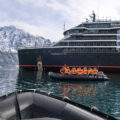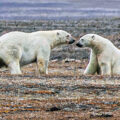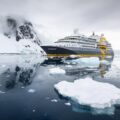
There’s a polar bear on our starboard side! The first of what would be many encounters with the Arctic’s iconic ice bears woke everyone up early on Seabourn Venture’s Northwest Passage voyage.
Guests rushed to the observation decks and trained binoculars on a polar bear on the prowl, regularly raising his head to sniff the air for a potential meal. But rather than being on an ice floe as we had expected, he was ambling along the rugged, rocky coast of Devon Island, scavenging rather than hunting.
Where’s the ice? It was a reality that began to haunt us as we sailed through calm, open waters at the end of a record-breaking warm summer in the Canada’s Arctic. While the Northwest Passage through the many islands in Canada’s far north is notorious for pack ice that in the past could trap ships for days or even years, this year saw so much melting that most of our route has been totally ice free.

On previous journeys in Canada’s north in decades past, I’d been in the same area of Nunavut in August and watched bears on ice floes waiting patiently for a seal or salmon to swim within paw range. This bear in 2023 was doing what he has to do: adapt. Through the morning, we had lengthy sightings of him roaming the shore before he finally located his lunch: a seal carcass that had washed up on a rocky beach.
We would get many more opportunities to observe polar bears and learn their fascinating habits on Seabourn Venture’s three-week expedition through the Northwest Passage, but every opportunity left us with the question: what if warm summers are the new normal? Can Arctic wildlife cope?
Experts in wildlife behavior on the cruise are optimistic, but concerned. Climate change continues to turn up temperatures and forces not only bears but other species adapted to perpetual freeze to find new ways to survive. Meanwhile, easier access to the Arctic threatens increased exploitation by humans in one of the last pockets of Earth with undisturbed nature.

Morten Jorgensen, a Danish wildlife specialist who consults with Seabourn has spent 20 years researching the situation and has written a book Polar Bears Beloved & Betrayed that lays out the human threat to bears.
Even though a polar bear conservation agreement was signed by all the countries in which polar bears live—Canada, Denmark, Norway, the United States and the then-USSR– in the 1970s and was extended indefinitely in 1981, polar bear numbers have not recovered. “Since 1973, almost 1,000 polar bears have been intentionally and for the most part legally shot every single year. That is an average of three polar bears killed every single day,”–two thirds of them in Canada, Jorgensen says.
And we learn that while other Arctic countries, including Russia, have banned polar bear hunting, “Canada has supported and encouraged a growth of its polar bear hunt including increased commercialization by building an industry around trophy hunting by overseas nationals as well as international trading in the body parts of dead polar bears,” Jorgensen writes. 
Bears having a discussion on Devon Island–Photo by Daniiel Fox on Seabourn Venture
While the hunting permits are technically only given to Inuit for subsistence, “the end consumers are anything but Inuit,” he’s found. They’re often sold to sport hunters or groups who export the bodies to China where their internal organs are sold for bear bile medicine that can bring tens of thousands of dollars. The outcome is “the polar bear loses,” he concludes.
Canada defends the policies by pointing out Environment Canada’s Convention on International Trade in Endangered Species (CITES) Appendix I does not consider polar bears populations endangered. Canada is home to approximately 16,000 of as many as 25 000 polar bears estimated to live in the global polar regions. About 2 per cent of the Canadian polar bear population—about 300 bears annually– enter international trade. “Harvest quotas are based on principles of conservation and Aboriginal subsistence, and are not market driven,” the Government of Canada website asserts.

While hunting can be controlled, the risk of being shut out of food by climate change is more problematic. On our cruise, Seabourn was doing everything to ensure that our visit is not part of the problem. When the bears decide to have a picnic on shore, we are not welcome to join. When a landing ashore is on the schedule and bears are in the vicinity, we either stay far offshore in Zodiacs or observe from the ship.
On days when we made landings ashore, advance scouts made sure we were not going to disturb wildlife, including walruses and seals. The expedition team always included trained bear watchers who are armed with rifles, but claim to have never actually had a situation where they had to fire in self defense.
And we had amazing opportunities for viewing bears. On one afternoon in where a beluga whale carcass had come ashore were able to float quietly offshore to observe at least eight bears who had converged for a meal. At one point two of the bears appeared to start to fight over the food, but it turned out they were playful cubs practicing their self-defense moves.

In daily background briefings aboard Seabourn Venture we also learned a lot of fun facts about the life of bears, and other wildlife we were encountering.
For instance: You can tell the sex of a bear even from a long distance. Female bears have tell-tale yellow stains on the fur of their rumps because they pee backwards, while males pee forward.
We also learned how nurturing mama bears are to their cubs. During two years together, the cubs mimic their mothers’ every move, learning how to hunt, swim, den, and migrate before they head out on their own. But there are some boomerang kids who try to hang around and get attention from mama for a third year as well. Mama–who might want some free time before having another brood–almost invariably gives in.
Another fun discussion is how seals have clever ways to avoid becoming prey when they come up for a breath of air in a hole in the ice. They’ve always got an emergency exit or two in other sections of ice and they change course if they see a shadow on their way to the surface.
We only wish that polar bears could talk and tell us what they really think about their rapidly changing Arctic homeland. What a discussion that would be.
Story by Wallace Immen, Executive Editor of The Cruisington Times






1 Trackback / Pingback
Comments are closed.